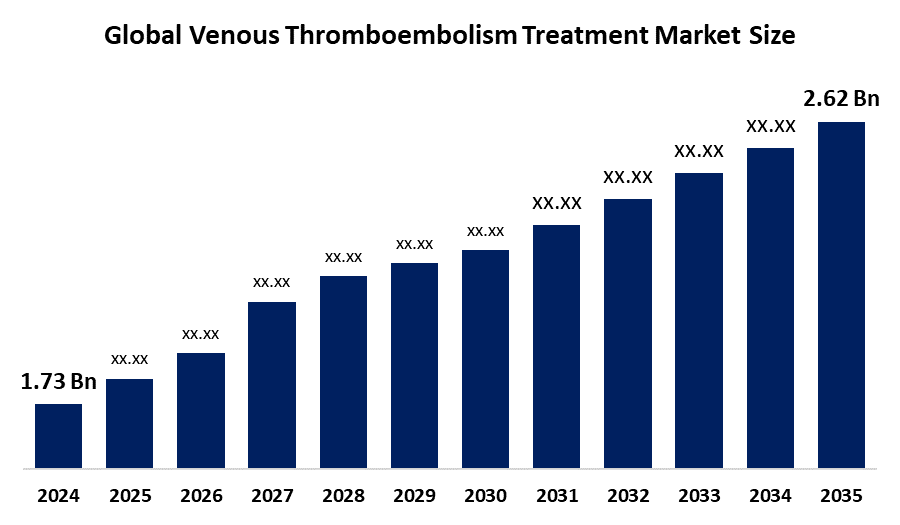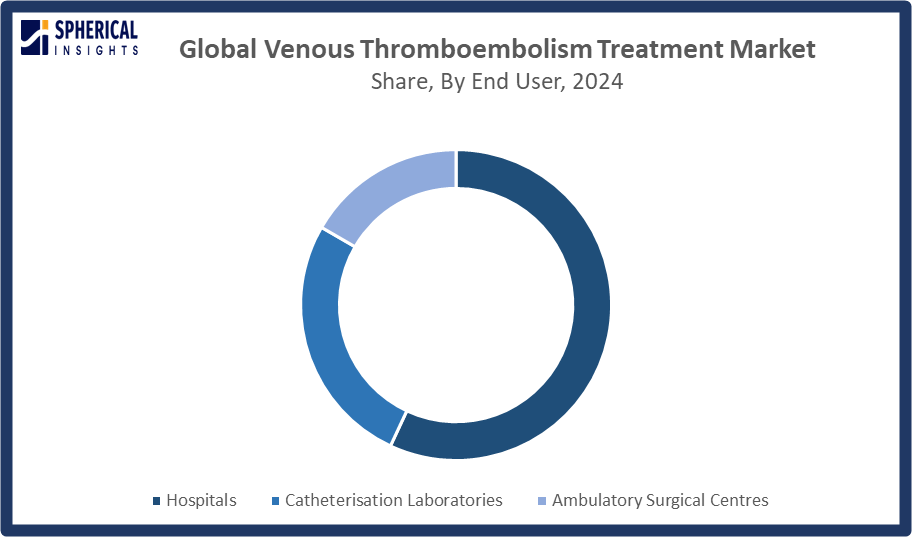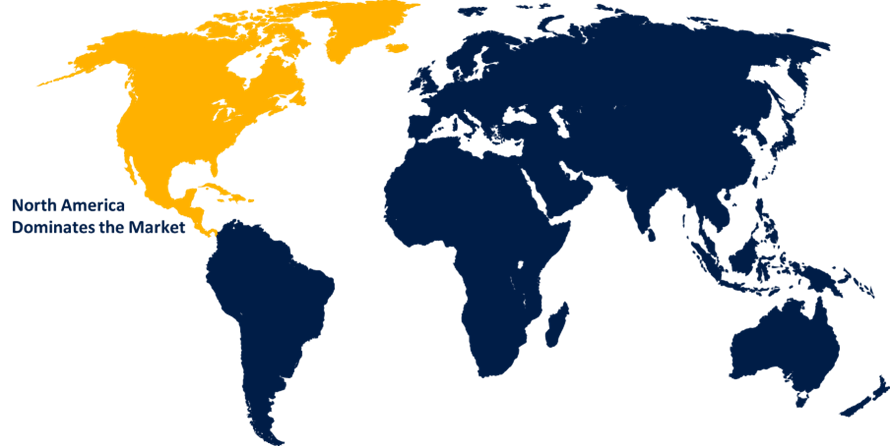Global Venous Thromboembolism Treatment Market Size, Share, and COVID-19 Impact Analysis, Russia-Ukraine War Impact, Tariff Analysis, By Product (Non-Segmented Pneumatic Compression Pumps, Segmented Pneumatic Compression Pumps without Gradient, Segmented Pneumatic Compression Pumps with Calibrated Gradient, Upper Pneumatic Compression Sleeves, Lower Pneumatic Compression Sleeves, Permanent Inferior Vena Cava Filters, Retrievable Inferior Vena Cava Filters, Embolectomy Balloon Catheters, Percutaneous Thrombectomy Devices, and Catheter-Directed Thrombolysis (CDT) Devices), By End User (Hospitals, Catheterisation Laboratories, and Ambulatory Surgical Centres), and By Region (North America, Europe, Asia-Pacific, Latin America, Middle East, and Africa), Analysis and Forecast 2025 - 2035
Industry: HealthcareVenous Thromboembolism Treatment Market Summary, Size & Emerging Trends
According to Spherical Insights, the Global Venous Thromboembolism Treatment Market Size is Expected to Grow from USD 1.73 billion in 2024 to USD 2.62 Billion by 2035, at a CAGR of 3.85% during the forecast period 2025-2035. The market for venous thromboembolism treatment offers opportunities for developing anticoagulant treatments, growing patient education initiatives, advancing diagnostic tools, and entering new healthcare markets with easier access to treatment and regulatory backing.

Get more details on this report -
Key Market Insights
- North America is expected to account for the largest share in the venous thromboembolism treatment market during the forecast period.
- In terms of product, the retrievable inferior vena cava filters segment is projected to lead the venous thromboembolism treatment market in terms of equipment throughout the forecast period
- In terms of end user, the hospitals segment captured the largest portion of the market
Global Market Forecast and Revenue Outlook
- 2024 Market Size: USD 1.73 Billion
- 2035 Projected Market Size: USD 2.62 Billion
- CAGR (2025-2035): 3.85%
- North America: Largest market in 2024
- Asia Pacific: Fastest growing market
Venous Thromboembolism Treatment Market
The global industry that develops, produces, and markets therapeutic solutions for the prevention, management, and treatment of venous thromboembolism is included in the venous thromboembolism treatment (VTE) market. The development of blood clots in the venous system, mainly deep vein thrombosis (DVT) and pulmonary embolism (PE), is a characteristic of VTE. In order to lessen clot formation and related consequences, this market includes a variety of therapy techniques, including mechanical treatments, thrombolytic medicines, and anticoagulants. Growing awareness of early diagnosis and treatment, improvements in pharmaceutical formulations, the prevalence of cardiovascular illnesses, and supporting regulatory frameworks are the main factors propelling the market. Rising VTE incidence in older populations, increased use of minimally invasive devices, and growing demand for retrievable medical devices, where clinical efficacy and patient safety are critical, will all influence the market's development. The growing need for clinically effective, patient-safe, and less invasive therapy options is causing a strategic shift in the market.
Venous Thromboembolism Treatment Market Trends
- Novel oral anticoagulants (NOACs) are becoming more widely used because of their better safety and effectiveness characteristics compared to conventional treatments.
- Increasing focus on targeted therapy and personalized medicine to improve treatment results and lessen side effects.
- Expansion of diagnostic developments that make it possible to identify and treat cases of venous thromboembolism early.
- Growing R&D expenditures were directed toward cutting-edge drug delivery methods and minimally invasive therapeutic approaches.
Venous Thromboembolism Treatment Market Dynamics
Global Venous Thromboembolism Treatment Market Report Coverage
| Report Coverage | Details |
|---|---|
| Base Year: | 2024 |
| Market Size in 2024: | USD 1.73 Billion |
| Forecast Period: | 2024-2035 |
| Forecast Period CAGR 2024-2035 : | 3.85% |
| 2035 Value Projection: | USD 2.62 Billion |
| Historical Data for: | 2020-2023 |
| No. of Pages: | 250 |
| Tables, Charts & Figures: | 130 |
| Segments covered: | By Product, By End User. |
| Companies covered:: | Pfizer Inc, Bayer AG, Merck & Co, DJO Global Inc., Cardinal Health Inc., Stryker Corporation, Wockhardt Ltd, Abbott Laboratories, Dupont Pharm Co, Janssen Pharmaceuticals Inc, Boehringer Ingelheim GmbH, Bristol-Myers Squibb Company, Upsher-Smith Laboratories, Inc., Bio Compression Systems, Inc., and Others. |
| Pitfalls & Challenges: | COVID-19 Empact, Challenge, Future, Growth, & Analysis |
Get more details on this report -
Driving Factors: Rising pulmonary embolism prevalence drives treatment demand.
The need for effective venous thromboembolism treatment is being driven by the rising prevalence of pulmonary embolism. The primary factors propelling the venous thromboembolism treatment market's expansion are the high prevalence of venous thromboembolism, the increasing incidence of cancer, the increasing number of secondary risk factors like diabetes and obesity, the rise in orthopedic surgical procedures, and the growing demand for minimally invasive treatment procedures. The need for effective treatment of venous thromboembolism is being driven by the rising incidence of cancer. Rising rates of thrombotic disorders, improvements in anticoagulant medications, an aging population, and increased knowledge of early detection and efficient treatment are the main factors propelling the venous thromboembolism treatment market.
Restrain Factors: Anticoagulant bleeding risks restrict growth market.
Despite being effective in preventing and treating VTE, the use of anticoagulants has a significant risk of bleeding complications, which restricts market expansion. The high expense of new anticoagulant treatments, the possibility of negative side effects like bleeding issues, and the restricted availability of cutting-edge medical facilities in developing nations are the main reasons impeding the market for venous thromboembolism treatment. Higher VTE treatment costs, particularly for more recent anticoagulant medications, may restrict market expansion.
Opportunity: New anticoagulants and tailored therapies create opportunities.
The development of new anticoagulant medications and tailored therapies that increase safety and efficacy has created substantial opportunities in the venous thromboembolism treatment market. There is a lot of room for expansion in emerging markets due to the expanding healthcare infrastructure and rising patient awareness. The market opportunities are further enhanced by pharmaceutical companies and healthcare providers working together to produce customized treatment regimes. In addition, encouraging regulatory environments and increased R&D expenditures help bring new treatments to market, increasing treatment alternatives and enhancing patient outcomes in the treatment of venous thromboembolism.
Challenges: Balancing bleeding risks complicates anticoagulation treatment.
The market for venous thromboembolism treatments faces challenges with striking a balance between the risk of bleeding problems and effective anticoagulation, which makes treatment regimens more difficult. Significant obstacles to the best results are also presented by patient non-compliance and adherence problems. Market expansion is further constrained in some areas by high treatment costs and restricted access to cutting-edge medical facilities. Furthermore, the industry continues to face difficulties due to strict regulatory regulations and the demand for constant innovation to meet changing clinical needs.
Global Venous Thromboembolism Treatment Market Ecosystem Analysis
The ecosystem of the global venous thromboembolism treatment market includes important players such as research organizations, patients, healthcare providers, pharmaceutical companies, and regulatory agencies. Innovation is fueled by pharmaceutical companies' creation of innovative anticoagulants and treatment options. In order to diagnose, treat, and manage patients, healthcare providers are essential. Regulatory bodies facilitate market approval procedures by ensuring adherence to safety and efficacy criteria. Evidence generation and clinical breakthroughs are facilitated by research institutions. Treatment results are strongly influenced by patient awareness and adherence. When these elements are combined, a dynamic and changing ecosystem is produced that promotes development and innovation in the field of venous thromboembolism treatment worldwide.
Global Venous Thromboembolism Treatment Market, By Product
The retrievable inferior vena cava filters segment led the venous thromboembolism treatment market, generating the largest revenue share. Retrievable inferior vena cava filters are preferred over permanent alternatives because of their better safety record, capacity to provide brief intervention, and lower risk of long-term problems. The capacity of retrievable IVC filters to offer immediate PE protection while permitting removal when the acute VTE risk has passed has led to their widespread use in both hospital and outpatient settings.
The catheter-directed thrombolysis (CDT) devices segment in the venous thromboembolism treatment market is expected to grow at the fastest CAGR over the forecast period. The growing use of less invasive treatments and the great effectiveness of CDT in treating complicated thrombotic diseases are the main factors driving the catheter-directed thrombolysis (CDT) devices market. The minimally invasive nature, great therapeutic efficacy, and expanding clinical use for difficult thrombotic situations are the reasons behind the catheter-directed thrombolysis (CDT) devices segment.
Global Venous Thromboembolism Treatment Market, By End User
The hospitals segment held the largest market share in the venous thromboembolism treatment market. Hospitals are offering complete VTE management in integrated healthcare settings, which includes diagnosis, acute care, and post-procedural care. The adoption of modern devices is supported by hospitals' purchasing power and procedural volumes, as well as their provision of multidisciplinary care coordination, which is crucial for the best possible patient outcomes.

Get more details on this report -
The ambulatory surgical centres segment in the venous thromboembolism treatment market is projected to register the fastest CAGR. The growing need for outpatient care with shorter recovery periods and fewer hospital stays, as well as the growing demand for affordable, less invasive operations, are driving the rise of the ambulatory surgery centers segment.
North America is expected to account for the largest share of the venous thromboembolism treatment market during the forecast period.

Get more details on this report -
The North American region is recognized for its sophisticated healthcare system, high rate of venous thromboembolism, prominent market participants, and growing awareness and use of innovative anticoagulant treatments. Numerous cutting-edge treatments and tools for managing VTE have been developed as a result of North America's high degree of technical advancement and focus on medical research.
The United States is experiencing steady growth in the venous thromboembolism treatment market.
The rising incidence of VTE, sophisticated medical facilities, continuous R&D, and the broad use of cutting-edge anticoagulant treatments are all contributing factors to the United States' consistent rise.
Asia Pacific is expected to grow at the fastest CAGR in the venous thromboembolism treatment market during the forecast period.
Increasing awareness of venous thromboembolism, the prevalence of risk factors including obesity and sedentary lifestyles, and the development of healthcare infrastructure in emerging nations like China and India are some of the reasons contributing to the Asia Pacific region. Additionally, expanding access to cutting-edge anticoagulant treatments and sophisticated diagnostic techniques is propelling market growth.
China is the largest market for venous thromboembolism treatment.
China's large population, rising venous thromboembolism rate, and notable improvements in healthcare infrastructure are the main causes. Furthermore, China's dominant position in the regional market is a result of growing awareness of and adoption of cutting-edge anticoagulant treatments.
Competitive Analysis:
The report offers the appropriate analysis of the key organizations/companies involved within the venous thromboembolism treatment market, along with a comparative evaluation primarily based on their type of offering, business overviews, geographic presence, enterprise strategies, segment market share, and SWOT analysis. The report also provides an elaborate analysis focusing on the current news and developments of the companies, which includes product development, innovations, joint ventures, partnerships, mergers & acquisitions, strategic alliances, and others. This allows for the evaluation of the overall competition within the market.
WORLDWIDE TOP KEY PLAYERS IN THE VENOUS THROMBOEMBOLISM TREATMENT MARKET INCLUDE
- Pfizer Inc
- Bayer AG
- Merck & Co
- DJO Global Inc.
- Cardinal Health Inc.
- Stryker Corporation
- Wockhardt Ltd
- Abbott Laboratories
- Dupont Pharm Co
- Janssen Pharmaceuticals Inc
- Boehringer Ingelheim GmbH
- Bristol-Myers Squibb Company
- Upsher-Smith Laboratories, Inc.
- Bio Compression Systems, Inc.
- Others
Key Target Audience
- Market Players
- Investors
- End-users
- Government Authorities
- Consulting And Research Firm
- Venture capitalists
- Value-Added Resellers (VARs)
Product Launches in the venous thromboembolism treatment
- In December 2023, the use of arterial and venous thrombectomy has gained greater prominence, rising significantly over five years. At the RSNA meeting, Harvard’s Dr. Stephanie McNamara unveiled research showing a 75% increase in procedures for venous thromboembolism (VTE) between 2017 and 2022. Despite this surge, McNamara noted that overall adoption remains low relative to total annual cases.
Market Segment
This study forecasts revenue at global, regional, and country levels from 2020 to 2035. Spherical Insights has segmented the venous thromboembolism treatment market based on the below-mentioned segments:
Global Venous Thromboembolism Treatment Market, By Product
- Non-Segmented Pneumatic Compression Pumps
- Segmented Pneumatic Compression Pumps without Gradient
- Segmented Pneumatic Compression Pumps with Calibrated Gradient
- Upper Pneumatic Compression Sleeves
- Lower Pneumatic Compression Sleeves
- Permanent Inferior Vena Cava Filters
- Retrievable Inferior Vena Cava Filters
- Embolectomy Balloon Catheters
- Percutaneous Thrombectomy Devices
- Catheter-Directed Thrombolysis (CDT) Devices
Global Venous Thromboembolism Treatment Market, By End User
- Hospitals
- Catheterisation Laboratories
- Ambulatory Surgical Centres
Global Venous Thromboembolism Treatment Market, By Regional Analysis
- North America
- US
- Canada
- Mexico
- Europe
- Germany
- UK
- France
- Italy
- Spain
- Russia
- Rest of Europe
- Asia Pacific
- China
- Japan
- India
- South Korea
- Australia
- Rest of Asia Pacific
- South America
- Brazil
- Argentina
- Rest of South America
- Middle East & Africa
- UAE
- Saudi Arabia
- Qatar
- South Africa
- Rest of the Middle East & Africa
Frequently Asked Questions (FAQ)
-
1. What is the CAGR of the venous thromboembolism treatment market over the forecast period?The global venous thromboembolism treatment market is projected to expand at a CAGR of 3.85% during the forecast period.
-
2. What is the market size of the venous thromboembolism treatment market?The global venous thromboembolism treatment market Size is expected to grow from USD 1.73 billion in 2024 to USD 2.62 billion by 2035, at a CAGR of 3.85% during the forecast period 2025-2035.
-
3. Which region holds the largest share of the venous thromboembolism treatment market?North America is anticipated to hold the largest share of the venous thromboembolism treatment market over the predicted timeframe.
-
4. Who are the top 10 companies operating in the global venous thromboembolism treatment market?Key players include in Pfizer Inc, Bayer AG, Merck & Co, DJO Global Inc., Cardinal Health Inc., Stryker Corporation, Wockhardt Ltd, Abbott Laboratories, Dupont Pharm Co, Janssen Pharmaceuticals Inc, Boehringer Ingelheim GmbH, Bristol-Myers Squibb Company, Upsher-Smith Laboratories, Inc., Bio Compression Systems, Inc., and Others.
-
5. What factors are driving the growth of the venous thromboembolism treatment market?The growth of the venous thromboembolism treatment market is driven by rising VTE prevalence, advancements in anticoagulant therapies, increased healthcare awareness, aging population, and improved diagnostic and treatment technologies.
-
6. What are the main challenges restricting wider adoption of the venous thromboembolism treatment market?The main challenges restricting wider adoption of the venous thromboembolism treatment market include high treatment costs, bleeding risks associated with anticoagulants, limited access in low-resource settings, and stringent regulatory requirements.
Need help to buy this report?